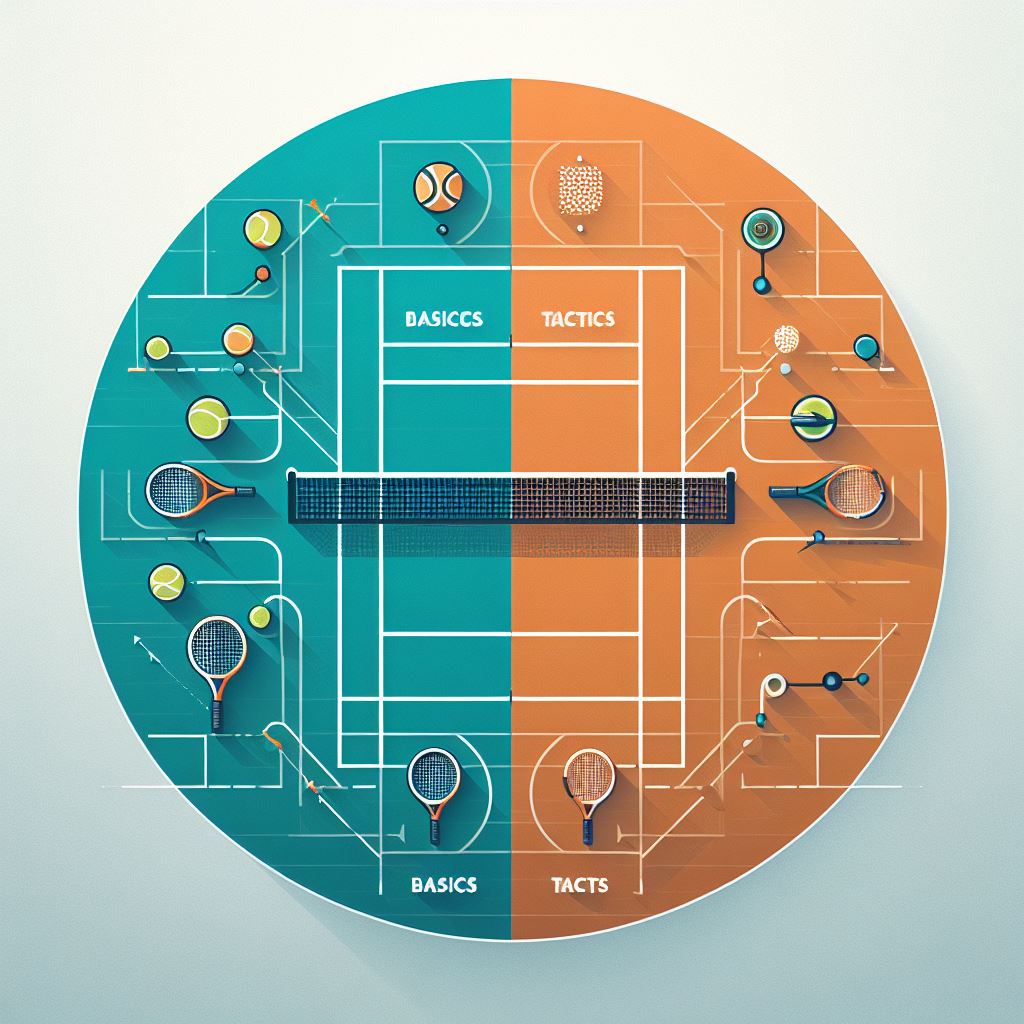Are you an aspiring amateur tennis player seeking to conquer the court with confidence? This article aims to arm you with the essential tennis basics that will elevate your game to new heights.
From mastering the art of grip and stance to perfecting your serve and groundstrokes, we will guide you step by step towards honing your skills.
Additionally, you’ll discover the secrets to developing effective footwork and strategies for both singles and doubles play.
Get ready to unleash your potential on the tennis court!
Key Takeaways
- Proper equipment selection and warm-up techniques are essential for amateur tennis players.
- Mastering the serving technique, including the continental grip and coordination of arm, shoulder, and wrist, is crucial.
- Developing mastery in groundstrokes involves shot selection, different types of groundstrokes, and utilizing power and control.
- Footwork development is important for agility, directional change, and maintaining a balanced stance.
Grip and Stance
Proper grip and stance are fundamental aspects of tennis technique. Finding the right equipment and implementing proper warm-up techniques are essential for an effective grip and stance.
When it comes to equipment, selecting the right tennis racket is crucial. The racket should feel comfortable in your hand, allowing for a firm grip without being too heavy or too light. It is also important to choose the right grip size to ensure maximum control and prevent injury. Consult with a tennis professional or try different grip sizes to find the one that suits you best.
Once you have the appropriate equipment, it is important to warm up properly before playing. This helps to prepare your body for the physical demands of the game and reduces the risk of injury. A warm-up should consist of dynamic stretches, such as arm circles and leg swings, to increase blood flow to the muscles and improve flexibility. It is also important to incorporate light jogging or jumping exercises to elevate your heart rate and warm up your entire body.
In terms of grip and stance, the Eastern grip is commonly used for forehand shots, while the Continental grip is preferred for serves and volleys. When it comes to stance, the open stance is often used for groundstrokes, while the closed stance is commonly employed for volleys and serves.
Mastering the Serve
To further improve your tennis skills, it is important to consistently work on mastering the serve, a crucial aspect of the game that requires precise technique and strategic execution. The serve is the starting point of every point in tennis, and a powerful and accurate serve can give you a significant advantage over your opponent.
To improve your serving techniques and increase power, you need to focus on a few key elements. First, your grip should be firm but relaxed, allowing you to generate maximum power while maintaining control. The most common grip used for serving is the continental grip, where the base knuckle of your index finger rests on the third bevel of the racket handle. This grip allows for versatility in serving and is widely used by professional players.
Second, your stance is crucial for generating power and balance. The ideal stance for serving involves starting with your feet shoulder-width apart, with your weight evenly distributed on both feet. As you begin your serving motion, transfer your weight from your back foot to your front foot, using the rotation of your hips and shoulders to generate power.
Lastly, your serving motion should be fluid and efficient, with a smooth coordination of your arm, shoulder, and wrist. The three main phases of a serve are the preparation, the toss, and the swing. During the preparation phase, hold the racket with both hands and keep it behind you, using your non-dominant hand to guide the racket into position. Then, toss the ball slightly in front and to the side of your body, ensuring it reaches the ideal hitting zone. As you swing, focus on snapping your wrist at the point of contact to generate additional power.
By consistently practicing these serving techniques and focusing on improving power, you can take your tennis game to the next level. Remember to be patient and persistent, as mastering the serve takes time and dedication. Keep practicing and refining your technique, and soon enough, you’ll have a serve that will leave your opponents struggling to return.
| Serving Techniques | Improving Power | Tips for Success |
|---|---|---|
| Firm but relaxed grip | Weight transfer | Practice regularly |
| Continental grip | Hip and shoulder rotation | Focus on technique |
| Shoulder-width stance | Fluid coordination | Be patient |
| Smooth serving motion | Wrist snap | Stay dedicated |
Perfecting Your Groundstrokes
Building on the foundation of mastering the serve, it is essential for amateur tennis players to focus on perfecting their groundstrokes. Groundstrokes are the shots hit after the ball has bounced once on the court. They include forehands and backhands, which are crucial for players to develop a well-rounded game.
Improving shot selection is a fundamental aspect of perfecting groundstrokes. Players must learn to assess the situation on the court and choose the appropriate shot based on factors such as their opponents’ position, court placement, and game strategy. This involves understanding the different types of groundstrokes, such as topspin shots, flat shots, and slice shots, and knowing when to utilize each one.
In addition to shot selection, enhancing power and control is crucial for effective groundstrokes. Players can achieve this by focusing on proper technique, footwork, and body positioning. Generating power comes from using the entire body, including the legs, hips, core, and shoulder rotation. Control is achieved through consistent practice and developing a feel for the ball, allowing players to place their shots accurately and with precision.
To perfect groundstrokes, players should dedicate time to drills that focus on shot selection, power, and control. This can involve practicing cross-court shots, down-the-line shots, and incorporating different spins into their strokes. By honing these skills, amateur players can elevate their game and become more confident in their groundstroke abilities.
Developing Effective Footwork
Enhancing agility and speed on the court is crucial for amateur tennis players looking to develop effective footwork. Good footwork allows players to quickly react to their opponent’s shots, maintain balance, and position themselves optimally for the next shot.
Here are three key strategies to develop effective footwork:
- Agility training: Agility drills help improve a player’s ability to change direction quickly and maintain balance. Exercises such as ladder drills, cone drills, and shuttle runs can enhance foot speed, coordination, and reaction time. Incorporating these drills into regular training sessions can significantly enhance a player’s footwork skills.
- Quick directional changes: Tennis is a dynamic sport that requires players to move swiftly in all directions. Practicing quick directional changes, such as moving forward and backward, side to side, and diagonally, can improve a player’s ability to transition smoothly on the court. Incorporating exercises like lateral shuffles, split steps, and crossover steps can help develop the necessary agility for quick changes in direction.
- Proper weight transfer: Effective footwork requires proper weight transfer while moving around the court. Players should focus on shifting their weight from one foot to another smoothly, ensuring a stable and balanced stance. Practicing drills that emphasize weight transfer, such as shadowing footwork patterns or hitting shots on the run, can help improve overall footwork efficiency.
Strategies for Singles and Doubles Play
Continuing the exploration of effective footwork, amateur tennis players can further optimize their game by employing strategic techniques for both singles and doubles play. In singles play, tactical positioning is crucial to gain an advantage over the opponent. By strategically positioning themselves on the court, players can control the flow of the game and exploit their opponent’s weaknesses. For example, a player can stand closer to the baseline to take advantage of their powerful groundstrokes, or move forward to put pressure on their opponent’s serve.
On the other hand, doubles play requires not only individual strategy but also effective communication with your partner. Communication in doubles play is essential to ensure coordination and avoid confusion on the court. Players must communicate their intentions, such as who will take the shot, who will cover the net, or when to switch positions. This allows for better teamwork and maximizes the chances of winning points.
To illustrate these concepts, here is a table showcasing some strategic techniques for both singles and doubles play:
| Strategy | Singles Play | Doubles Play |
|---|---|---|
| Tactical Position | Stand closer to the baseline | Cover different areas of the court |
| Communication | N/A | Clear and effective communication between partners |
Frequently Asked Questions
How Do I Choose the Right Tennis Racket for My Skill Level?
When choosing a tennis racket, it is important to consider factors such as your skill level, playing style, and personal preference. Finding the right grip size and weight are crucial for optimal performance on the court.
What Are Some Common Mistakes to Avoid When Serving in Tennis?
When serving in tennis, it is important to avoid common mistakes such as improper grip and inconsistent ball toss. Additionally, footwork and positioning play a crucial role in achieving an effective serve.
How Can I Improve My Timing and Accuracy When Hitting Groundstrokes?
Improving consistency, power, and control in groundstrokes requires a focus on timing and accuracy. By practicing proper footwork, maintaining a balanced stance, and using the kinetic chain effectively, players can enhance their shot-making abilities.
What Are Some Drills or Exercises That Can Help Me Improve My Footwork on the Tennis Court?
To enhance footwork in tennis, incorporating drills that focus on agility and exercises that strengthen the lower body is crucial. These activities improve coordination, speed, and balance, enabling players to move efficiently on the court and enhance their overall performance.
What Are Some Effective Strategies for Playing Against a Left-Handed Opponent in Singles or Doubles?
When facing a left-handed opponent in singles or doubles, it is important to adjust your strategy. Utilize cross-court shots to exploit their weaker backhand side and employ aggressive net play to disrupt their rhythm.
Conclusion
In conclusion, mastering the basics of tennis is crucial for amateur players looking to improve their game. By focusing on grip and stance, perfecting the serve, and developing effective footwork, players can enhance their overall performance on the court.
Additionally, understanding strategies for singles and doubles play can help players make strategic decisions during matches.
So why wait? Start practicing these fundamental skills today and take your tennis game to the next level.








No Comment! Be the first one.